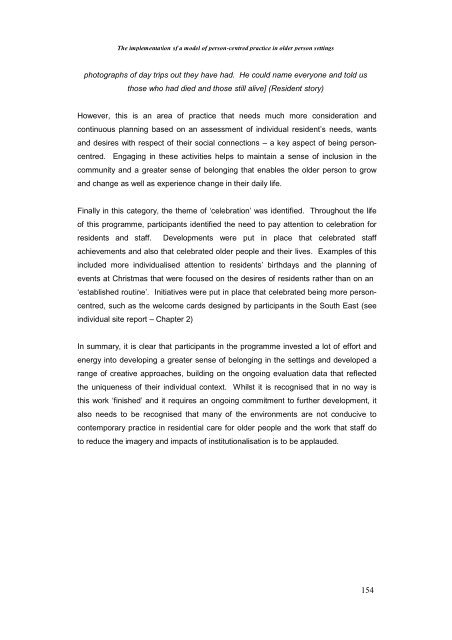The Implementation of a Model of Person-Centred Practice In Older ...
The Implementation of a Model of Person-Centred Practice In Older ...
The Implementation of a Model of Person-Centred Practice In Older ...
You also want an ePaper? Increase the reach of your titles
YUMPU automatically turns print PDFs into web optimized ePapers that Google loves.
<strong>The</strong> implementation <strong>of</strong> a model <strong>of</strong> person-centred practice in older person settings<br />
photographs <strong>of</strong> day trips out they have had. He could name everyone and told us<br />
those who had died and those still alive] (Resident story)<br />
However, this is an area <strong>of</strong> practice that needs much more consideration and<br />
continuous planning based on an assessment <strong>of</strong> individual resident’s needs, wants<br />
and desires with respect <strong>of</strong> their social connections – a key aspect <strong>of</strong> being personcentred.<br />
Engaging in these activities helps to maintain a sense <strong>of</strong> inclusion in the<br />
community and a greater sense <strong>of</strong> belonging that enables the older person to grow<br />
and change as well as experience change in their daily life.<br />
Finally in this category, the theme <strong>of</strong> ‘celebration’ was identified. Throughout the life<br />
<strong>of</strong> this programme, participants identified the need to pay attention to celebration for<br />
residents and staff. Developments were put in place that celebrated staff<br />
achievements and also that celebrated older people and their lives. Examples <strong>of</strong> this<br />
included more individualised attention to residents’ birthdays and the planning <strong>of</strong><br />
events at Christmas that were focused on the desires <strong>of</strong> residents rather than on an<br />
‘established routine’. <strong>In</strong>itiatives were put in place that celebrated being more personcentred,<br />
such as the welcome cards designed by participants in the South East (see<br />
individual site report – Chapter 2)<br />
<strong>In</strong> summary, it is clear that participants in the programme invested a lot <strong>of</strong> effort and<br />
energy into developing a greater sense <strong>of</strong> belonging in the settings and developed a<br />
range <strong>of</strong> creative approaches, building on the ongoing evaluation data that reflected<br />
the uniqueness <strong>of</strong> their individual context. Whilst it is recognised that in no way is<br />
this work ‘finished’ and it requires an ongoing commitment to further development, it<br />
also needs to be recognised that many <strong>of</strong> the environments are not conducive to<br />
contemporary practice in residential care for older people and the work that staff do<br />
to reduce the imagery and impacts <strong>of</strong> institutionalisation is to be applauded.<br />
154
















